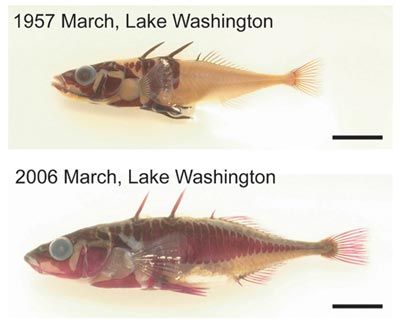'Reverse evolution' is found in Seattle fish (USA).
When an area of polluted lakes near Seattle is cleaned up, a small, prickly fish called freshwater sticklebacks must 'reverse engineer' to survive.
In the 1950s, Lake Washington, a terrestrial lake parallel to Washington State's Pacific Coast, suffered about 76 million liters of phosphorus-containing wastewater a day. Before the 1960s, it became a 121,400-hectare lake of waste water. Then a $ 140 million clean-up project in the mid-1960s turned the lake into a pristine paradise of today's boaters.
But the recovery of the lake endangers at least one species: three prongs sticklebacks. This small fish previously hid in the dark depths, suddenly in the clear view of the killer salmon.
The researchers now suggest that the threat of predators pushing fishes into evolution quickly returns to a more ancient form of life itself. According to Katie Peichel, biologist at Fred Hutchinson Cancer Research Center in Seattle, Lake Washington sticklebacks today are a step backwards from their ancestors, growing hard to defend.
'We call it' reverse evolution 'because sticklebacks are transforming into the shape of the ancestors, the sea stickleback, the original inhabitants of the lake.'
Peichel is the co-author of a new work on sticklebacks published in the May 20 issue of Current Biology.

The picture compares sticklebacks from Lake Washington in 1957 with 2006 fish in the same lake.(Photo: Katie Peichel / Fred Hutchinson)
Reverse evolution
There is not much reverse evolutionary evidence recorded but according to Peichel 'probably because people don't really pay attention.' For the case of sticklebacks, returning to the ancient pattern is reasonable.
When Lake Washington is contaminated, the view is about 76cm. Sticklebacks do not need armor to protect them because they protect them from the predator's view. In 1968, after the cleaning process was completed, the clarity of the lake water reached a depth of 3m. Today it reaches 7.6m.
Before bleaching, only 6% of the fish grew completely scales. Currently about 49% grow completely scales with body bones that protect the body from head to tail. About 35% grow locally in about half of the body. This quick and impressive adaptation is an example of reverse evolution because sticklebacks often evolve towards less scales, not more.
Evolution of fast speed
The speed of evolution is what impressed Peichel the most.'The biggest change took place between 1968/1969 and 1976. This speed is really fast.'
Sticklebacks in Lake Washington contain DNA from saltwater species, which tend to be completely scaly, and freshwater sticklebacks, which tend to have less scales.
'There are many genetic variants in the fish community which means that if the environment changes, there may be certain genetic variants that are more suitable for the new environment and so naturally choose it. Genetic variation increases the viability of species. '
Lake Washington sticklebacks have their ancestral life numbers similar to those of humans - about 10,000 lives. As a species in nature, human species face selective pressure that requires similar adaptations. For example, 'people in northern regions have lighter skin, and today these people are at risk for diseases like skin cancer.'
The study of stickleback fish does not offer a cure for the above-mentioned phenomenon of easy cancer. But people and sticklebacks share an Eda gene that forms fish scales. In humans, mutations in Eda can change skin, teeth and hair.
Continue to observe
Andrew Hendry, biologist at McGill University in Montreal, said the work is a valuable lesson in evolutionary biology.
'For me, it proves that people can profoundly influence the speed and direction of evolution in the organisms we touch.'
Michael A. Bell, an ecologist at Stony Brook University in New York, said the project " works together to create a fascinating story."
However, there are still unsatisfactory points.
'In western North Africa, there are clear lakes for both sticklebacks and predatory fish but they do not grow scales all over. Perhaps the authors are right, or there are other environmental impacts that they have not taken into account. '
For his part, Peichel looked at opportunities to study within Lake Washington.'We will continue by observing other characteristics that appear to have changed in sticklebacks, such as size and studying the genetic basis of these changes.'
A new study suggests that the sticklebacks may have 'evolved backwards' in Lake Washington, growing more scales to protect themselves after the lake cleanse makes them more clearly observed by predatory fish.
- Biological evolution
- 200-year-old fish in America
- Ancient fish 'monsters' used fins to walk
- Excavating fish fossils 429 million years old
- Ancient ancestors of humanity are fish?
- Evidence shows that humans evolved from fish
- Sea fish are descendants of river fish?
- Surprised: Fish that live in the dark ocean still see colors
- Catch the giant fish
- Observe the extremely rare 'reverse evolution' lizard species in the natural world for the first time
- Fish are invisibility
- Prev reverse evolution in mice.
 Animal 'suffering' after hibernation
Animal 'suffering' after hibernation Why do goats climb well?
Why do goats climb well? Scientists were surprised to see chimpanzees eating turtles
Scientists were surprised to see chimpanzees eating turtles Giant catfish died deadly due to drought in Thailand
Giant catfish died deadly due to drought in Thailand